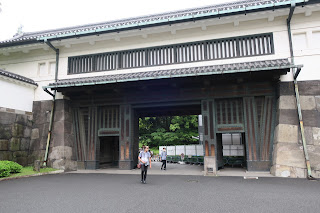The Tokyo Imperial Palace (Kokyo, literally 'Imperial Residence') is the main
residence of the Emperor of Japan.
It is a large park-like area located in the Chiyoda district of the Chiyoda
ward of Tokyo and contains several buildings including the Fukiage Palace
(Fukiage gosho) where the Emperor has his living quarters, the main palace
(Kyuden) where various ceremonies and receptions take place, some residences
of the Imperial Family, an archive, museums and administrative offices.
The 1.15-square-kilometer (0.44 sq mi) palace grounds and gardens are built on
the site of the old Edo Castle.
|
Tokyo Imperial Palace map.
From 1888 to 1948, the compound was called Palace Castle (Kyujo). On the
night of 25 May 1945, most structures of the Imperial Palace were
destroyed in the Allied firebombing raid on Tokyo.
-
Due to the large-scale destruction of the Meiji-era palace, a new main
palace hall (Kyuden) and residences were constructed on the western
portion of the site in 1964–1968, designed by architect Junzo
Yoshimura.
-
The area was renamed Imperial Residence (Kokyo) in 1948, while the
eastern part was renamed East Garden (Higashi-Gyoen) and became a
public park in 1968.
|
|
Ote-mon Gate.
Ote-mon Gate served as the primary gateway to the Edo Castle, utilized
by daimyos during their alternate attendance (sankin kotai) for New
Year’s or monthly ceremonies.
-
The Ote-mon Gate has borne witness to numerous historical events,
including the assassination of the chief minister of the shogunate and
the surrender of the shogunate to the imperial forces.
-
Despite being ravaged by fire several times, Edo Castle's current
Ote-mon Gate dates back to 1967.
|
|
Swan moat.
Although most of the historic moats of Edo Castle are gone, a dozen
still encircle Imperial Palace. Collectively they define the Outer
Gardens.
|
|
Edo Castle Ruins (Edo joseki).
The ruins of Edo Castle in Chiyoda City, Tokyo, are known for Japan’s
largest Tenshudai Base (the foundation on which the castle’s symbolic
and authoritative Tower was built), Yagura (the tower mainly built in
the corners of the castle for observation and defense), and stone walls.
-
Castles were a crucial symbol of the Tokugawa state order,
representing the realm of the daimyo and the privileges conferred by
the Tokugawa shoguns. Among them, Edo Castle stood out as the largest
and symbolized the supremacy of the Tokugawa house as the leader of
Japan’s warrior elite.
|
|
Ninomaru Garden (Ninomaru teien).
The Ninomaru Garden is considered a Shoin-zukuri style garden,
representing the world of Chinese mythological immortals.
-
Documentary and stylistic evidence suggests that this garden was laid
out around 1602–1603 (during the rule of Ieyasu), when Nijo-jo Castle
itself was built, in a style complementary to the architecture, with
some later modifications made on the order of Tokugawa Iemitsu in
preparation for the 1626 imperial visit by Emperor Go-Mizuno-o.
|
|
Nearby Wedding.
The Tokyo Imperial Palace is one of a number of popular photo spots for
newlyweds who want to snap commemorative pictures of themselves.
|
See also
Source
Location














